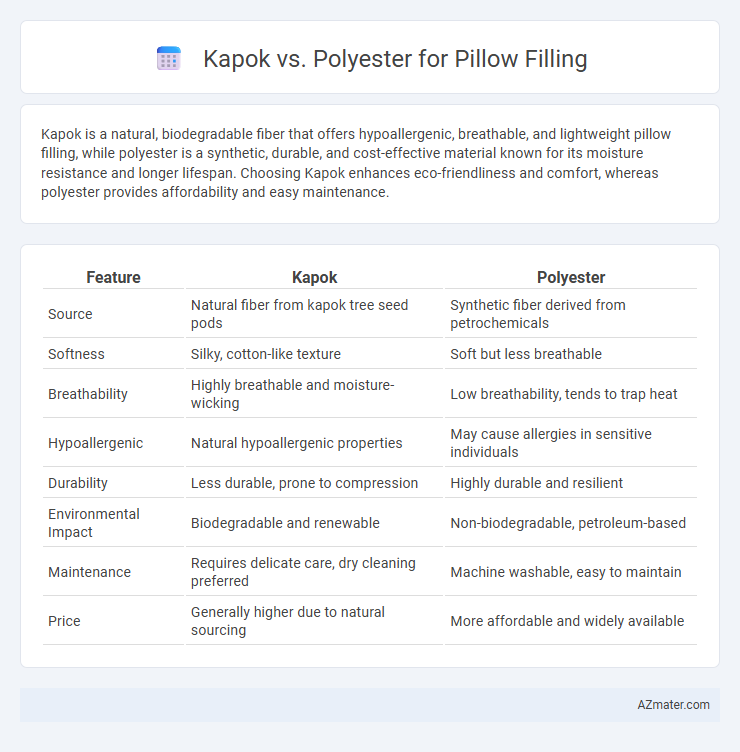Kapok is a natural, biodegradable fiber that offers hypoallergenic, breathable, and lightweight pillow filling, while polyester is a synthetic, durable, and cost-effective material known for its moisture resistance and longer lifespan. Choosing Kapok enhances eco-friendliness and comfort, whereas polyester provides affordability and easy maintenance.
Table of Comparison
| Feature | Kapok | Polyester |
|---|---|---|
| Source | Natural fiber from kapok tree seed pods | Synthetic fiber derived from petrochemicals |
| Softness | Silky, cotton-like texture | Soft but less breathable |
| Breathability | Highly breathable and moisture-wicking | Low breathability, tends to trap heat |
| Hypoallergenic | Natural hypoallergenic properties | May cause allergies in sensitive individuals |
| Durability | Less durable, prone to compression | Highly durable and resilient |
| Environmental Impact | Biodegradable and renewable | Non-biodegradable, petroleum-based |
| Maintenance | Requires delicate care, dry cleaning preferred | Machine washable, easy to maintain |
| Price | Generally higher due to natural sourcing | More affordable and widely available |
Introduction to Pillow Filling Materials
Kapok, a natural fiber harvested from the Ceiba tree, offers a hypoallergenic and eco-friendly alternative to synthetic fillings. Polyester, a widely used synthetic fiber, provides durability, affordability, and consistent loft for pillows. Selecting the right pillow filling hinges on factors such as breathability, support, and environmental impact.
What is Kapok?
Kapok is a natural fiber harvested from the seed pods of the kapok tree, known for its lightweight, hypoallergenic, and eco-friendly properties. Unlike synthetic polyester filling, kapok offers excellent breathability and moisture resistance, making it ideal for pillow stuffing with a soft, fluffy texture. This renewable resource is biodegradable, providing an environmentally sustainable alternative to petroleum-based polyester fibers.
What is Polyester?
Polyester is a synthetic fiber derived from petrochemicals, widely used for pillow filling due to its durability, lightweight nature, and hypoallergenic properties. It offers consistent loft and resilience, making it a cost-effective alternative to natural fillings like kapok. Unlike kapok, polyester is less breathable but excels in moisture resistance and easy maintenance.
Comfort Comparison: Kapok vs Polyester
Kapok offers a naturally soft and buoyant texture that adapts well to the shape of the head and neck, providing superior breathability and moisture-wicking properties compared to polyester. Polyester pillow filling tends to retain heat and lacks the natural resilience of kapok, often resulting in reduced airflow and cooler comfort levels. The hypoallergenic and eco-friendly attributes of kapok further enhance its appeal for comfort-focused pillow users seeking a sustainable alternative to synthetic polyester.
Allergies and Sensitivities
Kapok pillow filling is naturally hypoallergenic, resistant to dust mites, mold, and mildew, making it ideal for individuals with allergies or sensitive skin. Polyester filling may harbor allergens and irritants due to its synthetic fibers and tendency to retain moisture, potentially exacerbating allergic reactions. Choosing kapok helps reduce exposure to irritants and promotes a healthier sleep environment for allergy sufferers.
Sustainability and Eco-Friendliness
Kapok is a natural, biodegradable fiber harvested from the seed pods of the kapok tree, making it a highly sustainable and eco-friendly pillow filling option. Polyester, derived from petroleum-based synthetic fibers, has a larger environmental footprint due to its non-biodegradability and energy-intensive production processes. Choosing kapok over polyester significantly reduces plastic pollution and supports renewable resource use, aligning with eco-conscious consumer preferences.
Durability and Longevity
Kapok fibers are naturally strong and resistant to compression, providing long-lasting support that maintains loft without flattening quickly. Polyester, while affordable and widely used, tends to break down and lose shape over time, resulting in reduced durability and a shorter lifespan. Choosing kapok for pillow filling ensures enhanced longevity due to its resilient, biodegradable structure compared to synthetic polyester alternatives.
Care and Maintenance
Kapok pillow filling requires gentle care, including hand washing and air drying to maintain its natural softness and prevent clumping, while polyester fibers are machine washable and dry quickly, offering greater ease of maintenance. Kapok is biodegradable and may degrade faster if exposed to excessive moisture, necessitating careful storage to avoid mildew, whereas polyester is more resistant to mold and retains shape better over time. Choosing between Kapok and polyester fillings depends on prioritizing eco-friendly material handling versus convenience in care routines.
Cost Considerations
Kapok pillow filling generally costs more than polyester due to its natural, sustainable origin and limited supply. Polyester is a synthetic fiber produced in large quantities, making it significantly cheaper and widely accessible for budget-conscious consumers. Evaluating long-term durability and eco-friendliness can impact overall value, with kapok offering a premium feel at a higher price point compared to economical polyester options.
Which Pillow Filling is Right for You?
Kapok pillow filling offers a natural, hypoallergenic option with a soft, buoyant texture that provides excellent breathability and eco-friendliness, making it ideal for allergy sufferers and those seeking sustainable materials. Polyester filling delivers a more affordable, durable, and easily washable pillow with consistent loft, suitable for users prioritizing budget and low maintenance. Choosing between kapok and polyester depends on your preference for natural, breathable comfort versus cost-effective, resilient support.

Infographic: Kapok vs Polyester for Pillow filling
 azmater.com
azmater.com